BRP – Raw Water Project – Birmingham Resilience Project (2018)
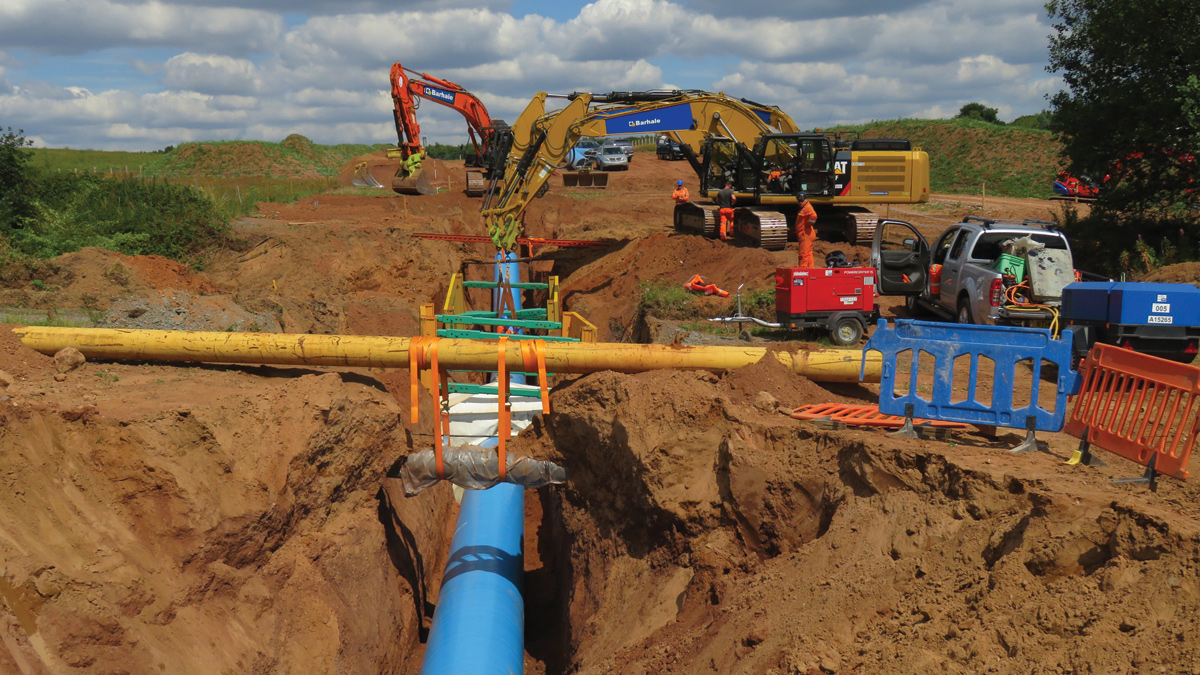
Laying the pipeline within the trench - Courtesy Severn Trent Water
The Birmingham Resilience Project aims to deliver a new water supply into Birmingham to allow extended planned maintenance shutdowns of the Elan Valley Aqueduct (EVA) as well as providing a back-up for any emergency events. The new supply will be brought into use every other year, for up to 50 days during months of October to March, to allow for planned maintenance on the Elan Valley Aqueduct. Emergency abstractions are expected to operate up to 70 days under the present abstraction licence. The Raw Water workstream is one of four projects that make up the Birmingham Resilience Project and requires the design and build of a 26km of pipeline from Lickhill to Frankley WTW via the existing inlet basin using 1067mm steel ductile pipe.
The pipeline
The pipeline crosses properties of over 100 landowners, using two methodologies of tunnelling and open-cut techniques. There are a total of 36 crossings, including motorways, major roads, canals and the railway. The major tunnels are constructed by first building a drive shaft to launch the tunnelling machine which then tunnels towards the drive shaft at a rate of 12m per day. The tunnelling machine is then removed at the reception shaft. Some of these shafts constructed range from 12m to 28m deep. The tunnel is then pipejacked using a 1050mm concrete pipe to which the steel ductile pipe is then inserted and welded together.
On the banks of the River Severn, Severn Trent Water (STW) is building a new river intake. From here there is a short tunnel of 1067mm ductile steel pipe up to a 4 (No.) pump high lift pumping station. The pipeline then leads us up to the break pressure tank, from where the pipeline carries on into Frankley WTW. All the works are contracted to Barhale plc, STW’s design and build contractor.
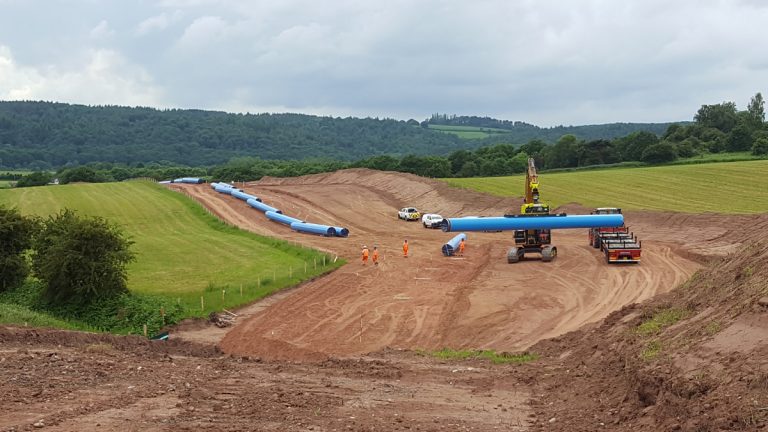
Stringing out the pipeline – Courtesy Severn Trent Water
How it works
During the Elan Valley Aqueduct shutdown, water will be abstracted from the River Severn under an abstraction licence with allowable abstraction limits of >40Ml/d between October and March. Raw water abstracted from the River Severn will pass through bar screens followed by fine band screens at the intake to remove coarse and fine debris. The band screens are backwashed with filtered river water to remove debris from the screens. Finer debris settles out in grit traps at the intake.
The current water quality in the River Severn is a different standard to what the existing Frankley WTW has previously been designed to treat from the Elan Valley Aqueduct. This requires a comprehensive water quality monitoring and control system to ensure that the raw water quality abstracted is fully managed at all times. If not, abstraction will be shut down (if already in progress) and inhibited. Water quality is monitored in three locations, the river upstream of the intake, the BPT and at Frankley.
The pumping station, which has 4 (No.) pumps, delivers water to the break pressure tank via the new pipeline. From there it then delivers water under gravity to Frankley Reservoir. Powered activated carbon (PAC) dosing takes place at the break pressure tank (and also Trimpley).
The raw water must receive PAC treatment for the primary treatment of pesticides, metaldehyde and partial organics removal and also negation of any odours that may be present in the River Water.
Once the water reaches the break pressure tank it then flows under gravity into Frankley Reservoir via the existing inlet basin, where it then sits before going into the new treatment plant.
Water for sweetening the Lickhill Aqueduct when no abstraction is taking place is extracted from the Frankley Reservoir inlet chamber and pumped to the break pressure tank along the Lickhill Aqueduct. Sweetening water then flows under gravity from the break pressure tank to the Lickhill Pumping Station and river intake where it is discharged into the River Severn.
The water sweetening cycle will include an initial flush when the Lickhill high lift pumps are inhibited. The duty sweetening pump shall run at a rate of 3.2Ml/day 7 days per week (operator HMI setting) to remove any standing River Severn Water from the Lickhill Aqueduct and break pressure tank. After the initial flushing the duty sweetening pump shall run periodically to ensure the Elan Valley Water is fully refreshed.
After the initial sweetening flushing the sweetening system will operate for a minimum of 18 hours per week at 3.2Ml/d ensuring the Elan Valley water is refreshed every 60 days.
Again, water quality is monitored in the river upstream of the Intake at the break pressure tank and at the Frankley Reservoir connection.
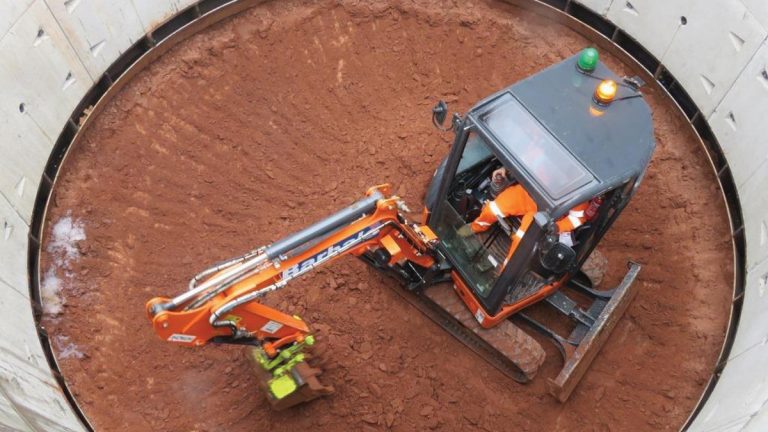
Drive shaft for one of the tunnels – Courtesy Severn Trent Water
Processes
The project comprises the following main processes:
River intake
- 3 (No.) bar screens.
- 3 (No.) band screens with filtered backwash river water.
- Settlement grit traps.
- Facilities for bio-bullet dosing to remove zebra mussels.
- Sample pumps.
Pumping station
- 4 (No.) high lift pumps (duty/duty/duty/standby).
- Cooling and wash water system.
- An aqueduct to a break pressure tank.
- A surge suppression system.
- Water quality monitoring.
- Flow monitoring.
Break pressure tank
- A break pressure tank.
- Portable bio-bullet dosing.
- Water quality monitoring.
- Flow monitoring.
Frankley WTW
- A sweetening flow with 2 (No.) pumps.
- operating as duty/standby.
- A flow control valve.
- EVA penstocks.
- Water quality monitoring.
- Flow monitoring.
Construction
River intake: A cofferdam (of H-piles and steel sheets) in the River Severn protects construction of the main structure which consists of a secant-piled rectangular box in the river bank. The rotating fine intake screens are protected by trash screens and there is provision to insert stoplogs if isolation is required for maintenance purposes. Equipment is contained within a security cage. The heaviest item could be lifted out for maintenance by a 220T mobile crane sitting on a custom-built crane pad.
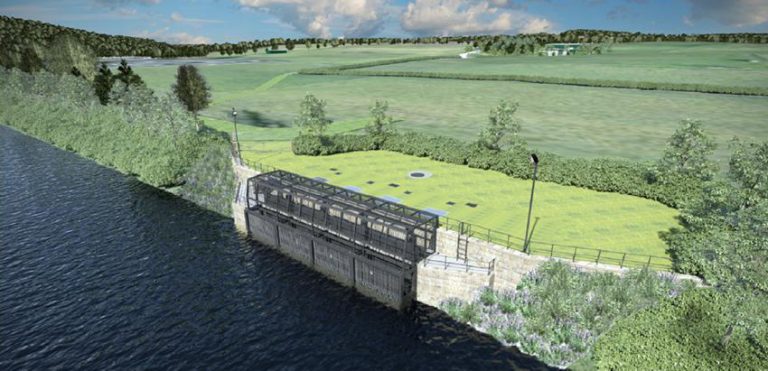
Artists impression of the intake structure – Courtesy Severn Trent Water
High lift pumping station: The 12m diameter wet well is a secant-piled shaft which is spray-concrete-lined to become the permanent works. The pipe gallery is a concentric 16m diameter secant-piled shaft which is spray-concrete-lined to become the permanent works. The motor floor above the pipe gallery is supported on precast concrete beams across the 16m diameter shaft. The rest of the main floor is a suspended slab, on ground beams supported off bearing piles.
The superstructure is steel framed and clad. Readily removable roof cladding would ensure that the high lift pump/motors could be lifted out for maintenance by a 220T mobile crane sitting on a custom-built crane pad outside the building.
Break pressure tank: Precast concrete components were used. ‘Factory thinking’ ensured excellent quality at no extra cost, speedy installation, less construction vehicle movements – welcomed by the residents of Romsley, hence good public relations.
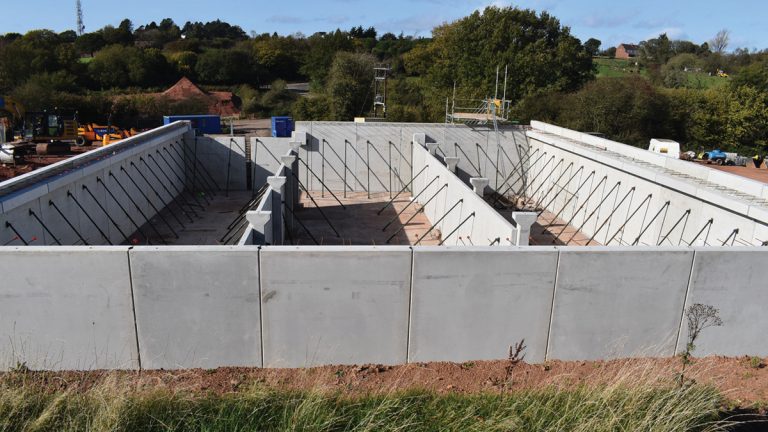
Construction of the break pressure tank – Courtesy Severn Trent Water
Lickhill Aqueduct: The 25km-long 1045NB welded steel transmission main is laid mainly in open-cut trench; but also in 3km of micro-tunnels (1500NB/1800NB) to cross under a railway line, a motorway, major roads, a flood plain, a canal, a steep-sided old village, an ancient woodland and a hazardous tip. Another trenchless method, auger-boring, was used to cross dozens of minor roads.
PAC dosing systems: Using the concept of ‘factory thinking’ all dosing equipment is assembled in steel shipping containers and tested in the specialist supplier’s workshop. These containers will be installed on a reinforced concrete raft at each location (Romsley/Trimpley). PAC silos for each location are also installed on the raft.
Undertakings
The key participants involved the Birmingham Resilience Project – Raw Water Workstream are:
- Designers to Severn Trent: Jacobs
- Design and build contractor: Barhale plc
- Geotechnical investigation: Geotechnics Ltd
- Ductile steel pipe: Pipe Source UK Ltd
- Valves: Severn Utilities Valves
- PAC dosing: Transvac Systems Ltd
- Piling: J Murphy & Sons Ltd
- Aarsleff sheet piled cofferdam: Aarsleff Ground Engineering
- Pipe fittings, bends, tees, reducers: George Green (Keighley) Ltd
Progress
Works commenced on site in 2017 and at the time of writing (April 2018) 17,200mts of pipeline have been installed, the break pressure tank is 70% complete and the intake and pumping station is 30% complete. The first section scheduled for commissioning tests in March 2019 will be the break pressure tank to Frankley section. Overall completion is scheduled for December 2019 where entire length from the Lickhill into Frankley will be tested.











